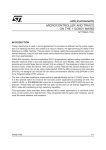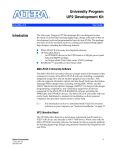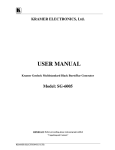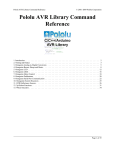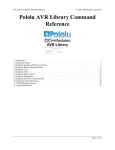Download Micro serial servo controller user`s guide
Transcript
Micro Serial Servo Controller User’s Guide Specifications PCB size........................................... Number of servo ports...................... Pulse width range............................. Resolution........................................ Supply voltage................................. I/O voltage....................................... Baud rate.......................................... Current consumption........................ Pololu © 2005 http://www.pololu.com/ 0.91" x 0.91" 8 0.25-2.75 ms 0.5 microsecond (~ 0.05 degree) 5-16 V 0 and 5 V 1200-38400 (auto detect) 5 mA (average) SSC03A ! Important Safety Warning The servo controller module is not intended for young children! Younger users should use this module only under adult supervision. By using this product, you agree not to hold Pololu liable for any injury or damage related to the use or to the performance of this product. This product is not designed for, and should not be used in, applications where the malfunction of the product could cause injury or damage. Contacting Pololu You can check the Pololu web site at http://www.pololu.com/ for the latest information about the servo controller, including color pictures, application examples, and troubleshooting tips. We would be delighted to hear from you about your project and about your experience with our servo controller. You can contact us through our online feedback form or by email at [email protected]. Tell us what we did well, what we could improve, what you would like to see in the future, or anything else you would like to say! Servo Controller Layout and Pinout protocol selection jumper LEDs: yellow green red Pololu © 2005 http://www.pololu.com/ sign al reset logic-level serial output logic-level serial input VIN (5-16 V) GND Vcc = Vs jumper RS-232 serial GND input + – servo power (4-6 V) servo 0 servo 1 servo 2 servo 3 servo 4 servo 5 servo 6 servo 7 + – 2 Connecting the Servo Controller The servo controller connections are shown on the facing page, and most of the pins are labeled on the back of the servo controller. All square pads are ground. Power The servos are typically powered by their own supply consisting of a 4- or 5-cell rechargeable battery pack with a nominal voltage of 4.8-6.0 volts. This supply can be connected to the upper-right corner of the board, or to any of the servo 0 through servo 6 power pins (the connection between the servo 7 pins and the other pins is not designed to carry the current for all of the servos). The servo supply should be capable of providing several amps of current. If many servos will be straining simultaneously, the total current can be close to 10 amps. In such applications, you should use the servo controller PCB just for signals and separately wire up the power and ground pins of the servos individually. The servo controller needs its own power, which can be 5-16 volts. This supply should be applied to the lower-left corner of the board, at the VIN and GND pins. If the servo battery pack is above 5 V, it can also power the servo controller. If the servo battery is under 5 V (a 4-cell pack), the servo controller can be powered by connecting across the Vcc = Vs jumper (and leaving VIN disconnected). Please note that both the servo controller and most servos can be destroyed by applying power incorrectly (either too high of a voltage or reversed voltage). Control signals The servo controller requires a logic-level (0-5 V) serial input connected to the logiclevel serial input or an RS-232-leve serial input at the RS-232 pin. Do not use both serial inputs at the same time! The V+ (red) servo controller echoes all serial data out of the serial output pin, and the reset line can be brought low to reset the servo signal controller. In most applications, the reset input and serial (white) output can be left disconnected. Servos When connecting servos, be careful because it is possible to plug in a servo backwards. Make sure to connect your servos correctly, or they may be destroyed. The signal (usually white or yellow) wire should be toward the inside of the board, and the black wire should be closest to the edge of the board. GND (black) servo connector 7 S+ Pololu © 2005 http://www.pololu.com/ header (on PCB) - 3 Using the Servo Controller The Pololu servo controller performs the processor-intensive task of simultaneously generating 8 independent servo control signals. The servo controller can generate pulses from 0.25 ms to 2.75 ms, which is greater than the range of most servos, and which allows for a servo operating range of over 180 degrees. Internally, the servo controller maintains a servo position value that is two times the pulse width, measured in microseconds. Thus, the 1.5 ms neutral position, which is 1500 microseconds long, is represented internally as 3000. The internal values range from 500 to 5500. Various interface modes allow the user to set the position value for each servo in multiple ways, which are described below. Serial Input The serial commands sent to the servo controller must be sent eight bits at a time, with no parity and one stop bit (sometimes abbreviated 8N1). Logiclevel serial input must be non-inverted, meaning that a zero is sent as a low voltage, and a one is sent as a high voltage, as shown in the diagram to the right. Any inverted serial input, whether at logic levels or at RS-232 levels, may be connected to the RS-232 serial input. LSB 5V MSB 10011010 0V start bit stop bit When you turn on power with your serial input connected, you should either see all of the LEDs or just the yellow LED turn on. After the servo controller turns on and determines the communication mode (see below), it waits for a serial input to determine the baud rate. If the input line is low, it turns all LEDs on and waits for the line to go high, which is the idle state for the serial line. Once the line is detected to be high, only the yellow LED is turned on, and the servo controller waits for a serial input. If the detected baud rate is too high, the red LED will turn on and the green LED will flash quickly. If the serial rate is too slow, the red LED will turn on and the yellow LED will flash. From this point on, the servo controller behavior depends on the communication mode. Once you choose a baud rate, all subsequent transmissions must be at that same baud rate. Indicator LEDs The green LED indicates serial activity: it should flicker whenever the servo controller receives data. The yellow LED indicates a warning regarding position: either the absolute or neutral position you have requested is out of range, or a combination of neutral, range, and 7-bit or 8-bit position caused the internal position variable to go out of range. The position will just be limited to the max or min, and the yellow LED will go out when all requested positions are in range. The red LED indicates a fatal error that prevents further operation (for example, a fatal error could be caused by invalid serial input). Pololu © 2005 http://www.pololu.com/ 4 Interface Options You can communicate with the servo controller using one of two communication protocols. One of the two interface modes is chosen based on the state of mode selection jumper when the servo controller is powered up; you cannot change modes without resetting the servo controller. Pololu Mode: The default mode, when the jumper is open (no shorting block), is a Pololu protocol used for controlling multiple serial devices. In this mode, the servo controller can be on the same serial line as other devices such as our Dual Serial Motor Controller. This mode also allows access to all of the special features of the servo controller, such as setting speeds, ranges, and neutral settings. Mini SSC II Mode: This mode is set by placing the shorting block over the two jumper pins. This setting allows the servo controller to respond to the protocol used by the Mini SSC II servo controller made by Scott Edwards Electronics. This protocol is more simple, but it only allows the user to specify the desired servo positions in only one way. In this mode, the servo controller is not compatible with other Pololu serial peripheral products. Mini SSC II Mode Baud Rate. The available baud rate range in this mode is approximately 500-10k baud, but the Mini SSC II only works at 2400 or 9600 baud. If you want to put a Mini SSC II servo controller on the same serial line as your Pololu 8-servo controller, you must use one of the two baud rates that the Mini SSC II can support. Protocol. To set the servo position, send a sequence of three bytes. The first byte is a synchronization value that must always be 255. Byte 2 is the servo number, and it can be 0-254. Byte 3 is the position to which you want the servo to move, also 0-254. start byte = 0xFF servo number, 0x00-0xFE Servo position, 0x00-0xFE Two motion ranges are available in this mode. Each Pololu servo controller responds to 16 servo numbers. Addressing the lower 8 will move them within an approximately 90 degree range, while addressing the upper 8 servo numbers will give twice the range. You can set the group of servo numbers to which your servo controller responds (see “Setting and Checking the Servo Numbers”). For example, if your servo controller is set to servo numbers 0, it responds to servo numbers 0-15, and sending the command sequence [255, 10, 254] will move servo 2 all the way to one extreme of its range in 180 degree mode. If you send servo numbers that are not recognized, the servo controller will ignore the command. Up to sixteen servo controllers can be connected on one serial line to control up to 128 servos independently. Pololu © 2005 http://www.pololu.com/ 5 Pololu Mode In this mode, there are several options for controlling your servos. As mentioned at the beginning of this section on page 4, the servo controller holds an internal variable for each servo, the value of which ranges from 500 to 5500, where the number corresponds to the pulse length in increments of half of a microsecond. The various commands deal with setting these internal values. With absolute commands, you simply set the value for each servo. In 7- and 8-bit modes, you set neutral, range, and direction parameters for each servo; then, when you send a 7- or 8-bit position command, the servo controller combines all of the parameters to obtain the actual servo position. Whether you use absolute commands or not, you can individually control the speed of each servo and whether the servo is on or off (most servos shut off when they receive no pulses). This section describes the interface details. Baud Rate. The available baud rate range in this mode is approximately 2,000-40,000 baud. It is possible for the servo controller to operate at rates as high as 57600 baud, but the success of the attempt will depend on the exact speed of your serial control source. The servo controller is not committed to standard baud rates, so if you have a device that can transmit at a maximum rate of 45,000 baud, try it, and it might work. Protocol. To communicate with the servo controller, send sequences of five or six bytes. The first byte is a synchronization value that must always be 0x80 (128). Byte 2 is the Pololu device type number, which is 0x01 for the 8-servo controller. Byte 3 is one of six values for different commands to the controller; the commands are discussed below. Byte 4 is the servo to which the command should apply. Bytes 5 and possibly 6 are the data values for the given command. In every byte except the start byte, bit seven must be clear. Thus, the range of values for bytes 2-6 is 0-0x7F (0-127). start byte = 0x80 device ID = 0x01 command servo num data 1 data 2 Command 0: Set Parameters (1 data byte) " " " Bit 6 specifies whether a servo is on or not; a 1 turns the servo on, and a 0 (default) turns it off. Bit 5 sets the direction the servo moves, which only applies to 7- and 8-bit position commands. If the bit is 0 (default), a larger position number causes the output pulse to get bigger; if the bit is 1, a larger position number will make the output pulse shorter. bit 7 bit 0 0x x x x x x x bits 0-4: range bit 5: direction 0 = forward 1 = reverse bit 6: servo on/off 0 = off 1 = on Bits 0-4 set the range through which the servo moves in 7- and 8-bit commands. A larger value will give a bit 7: always 0 larger range, and setting the range to 0 will make the servo always stay at neutral. Given the same range setting, an 8-bit position command will move the servo through twice the range of a 7-bit position command. The default range setting is 15, which will give a range of approximately 180 degrees in 8-bit commands and 90 degrees in 7-bit commands. Pololu © 2005 http://www.pololu.com/ 6 Pololu Mode (continued) Command 1: Set Speed (1 data byte) This command allows you to set the speed at which the servo moves. If the speed is set to 0 (default), the output pulse will instantly change to the set position. If the speed value is nonzero, the pulse changes gradually from the old position to the new position. With a speed of 1, the pulse width changes at 50 microseconds per second; the maximum speed of 6.35 ms per second is achieved with a speed setting of 127. Command 2: Set Position, 7-bit (1 data byte) When this command is sent, the data value is multiplied by the range setting for the corresponding servo and adjusted for the neutral setting. This command can be useful in speeding up communications since only 5 total bytes are sent to set a position. Setting a servo position will automatically turn the servo on. Command 3: Set Position, 8-bit (2 data bytes) This command is just like the 7-bit version, except that two data bytes must be sent to transfer 8 bits. Bit 0 of data 1 contains the most significant bit (bit 7), and the lower bits of data 2 contain the lower seven bits. (Bit 7 in data bytes must always be 0.) Setting a servo position will automatically turn the servo on. Command 4: Set Position, Absolute (2 data bytes) This command allows direct control of the internal servo position variable. Neutral, range, and direction settings do not affect this command. Data 2 contains the lower 7 bits, and Data 1 contains the upper bits. The range of valid values is 500 through 5500. Setting a servo position will automatically turn the servo on. Command 5: Set Neutral (2 data bytes) Setting neutral only applies to 7- and 8-bit commands. The neutral value sets the middle of a range, and corresponds to a 7-bit position value of 63.5 or an 8-bit position value of 127.5. The neutral position is an absolute position just like in command 4, and setting the neutral position will move the servo to that position. The default value is 3000. It may be useful to change neutral if you change servos and need to calibrate your system, or if you cannot get your mechanical linkages to just the right lengths. Tip: Setting neutral and servo direction can be useful if you have a device, such as a walking robot, that has multiple symmetrical structures on two sides of a chassis. Instead of determining a sequence of positions for each leg individually, you can design a single leg, and then use the same position values for other legs, changing only the neutral position and direction as necessary. Pololu © 2005 http://www.pololu.com/ 7 Setting and Checking the Servo Numbers The micro-servo controller has the unique feature of allowing the user to set the servo numbers to which the controller responds. By default, the servo controller responds to servo numbers 0-7 (in Pololu mode), but you can set it to respond to numbers 8-15, 1623, all the way to 120-127. (In Mini SSC II mode, the servo controller would respond to numbers 0-15, 16-31, all the way through 240-254.) This feature is useful if you want to use more than one servo controller at a time to control up to 128 independent servos. To set the servo numbers, put the servo controller in Pololu mode (shorting block removed from J1) and send the serial sequence [128, 2, <servonums>], where <servonums> is a number from 0 through 15. A setting of 0 will make the servo controller respond to servo numbers 0-7 (in Pololu mode), a setting of 1 will make it respond to servo numbers 8-15, and so on. start byte = 0x80 change servo numbers = 0x02 new setting, 0x00-0x10 Upon receiving the command, the servo controller will turn on the red and yellow LEDs and quickly flash the green LED <servonums> + 1 times. The green LED will thus quickly flash 1-16 times. The green LED will then pause for approximately 1 second before flashing again. The 8-servo controller must be reset (power turned off and back on) before it can be used. If you want to just see the servo numbers setting without changing it, use the above command, but use the value 16 for <servonums>. The servo number settings will remain unchanged, but the green LED will flash to indicate the servo numbers, as described above. The configuration of the servo controller should only be done once per servo controller, with only one servo controller on the serial line (otherwise, all units would get set to the same number, and the whole point is to give them unique numbers!). The number is stored in a location that can be written thousands of times, but the number should not be written every time your system is powered up. Pololu © 2005 http://www.pololu.com/ 8









